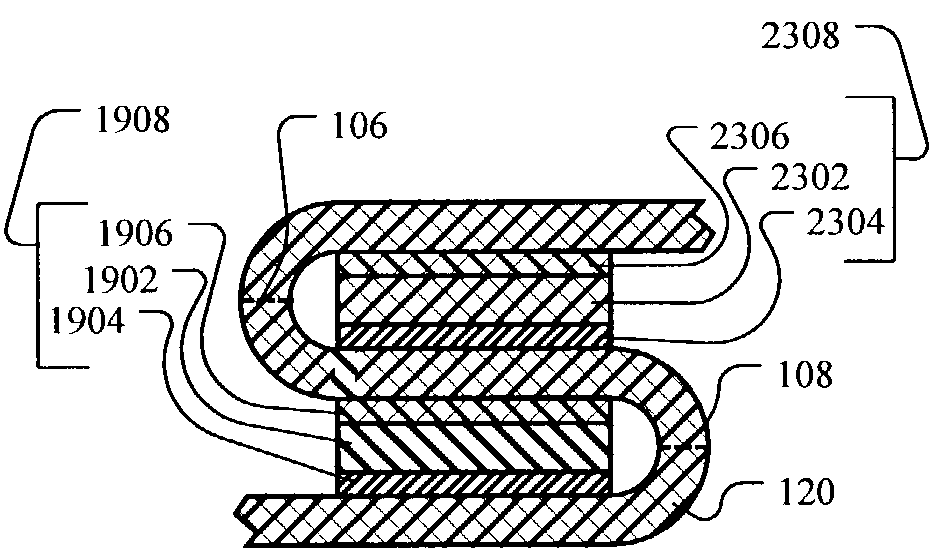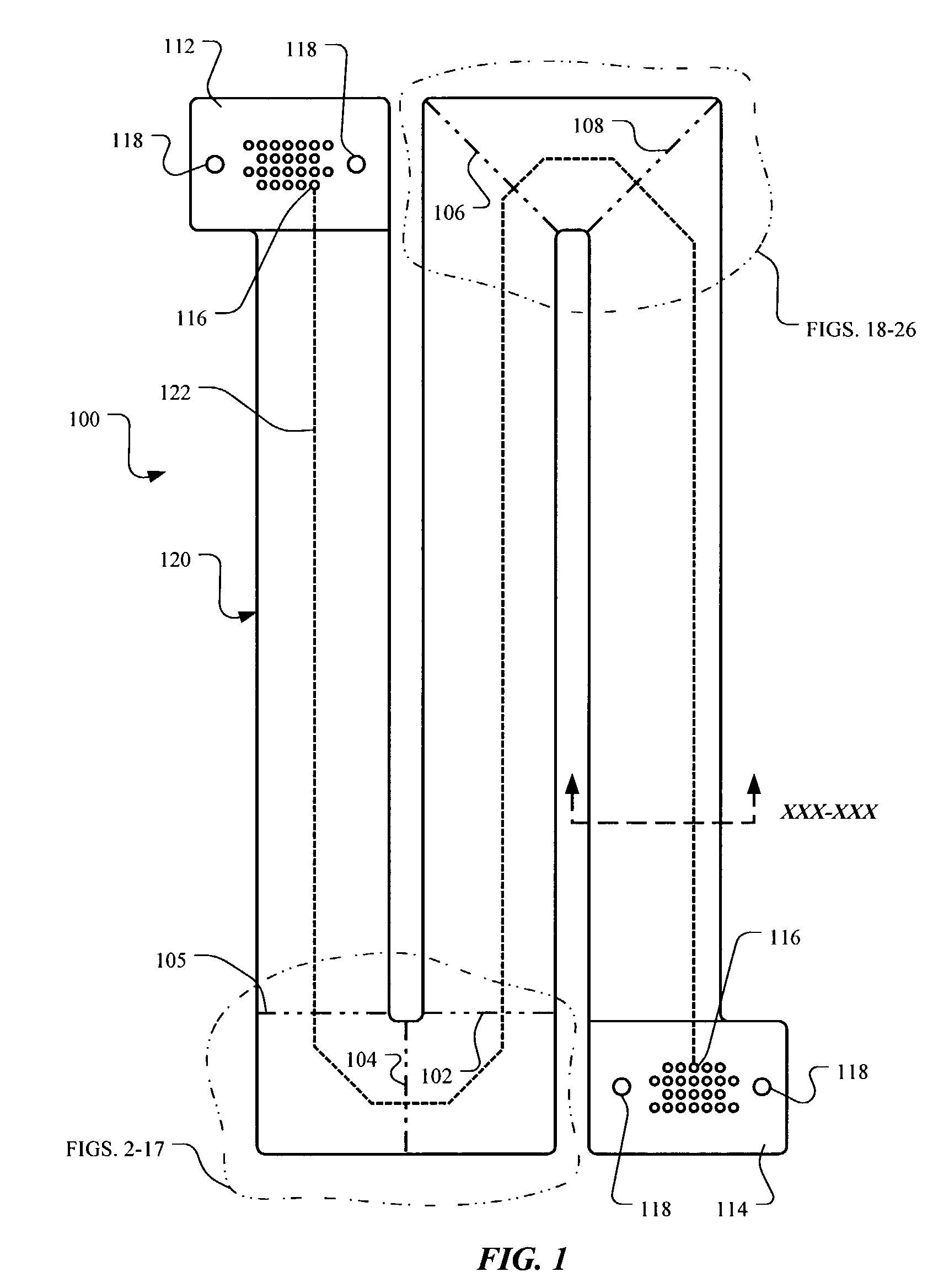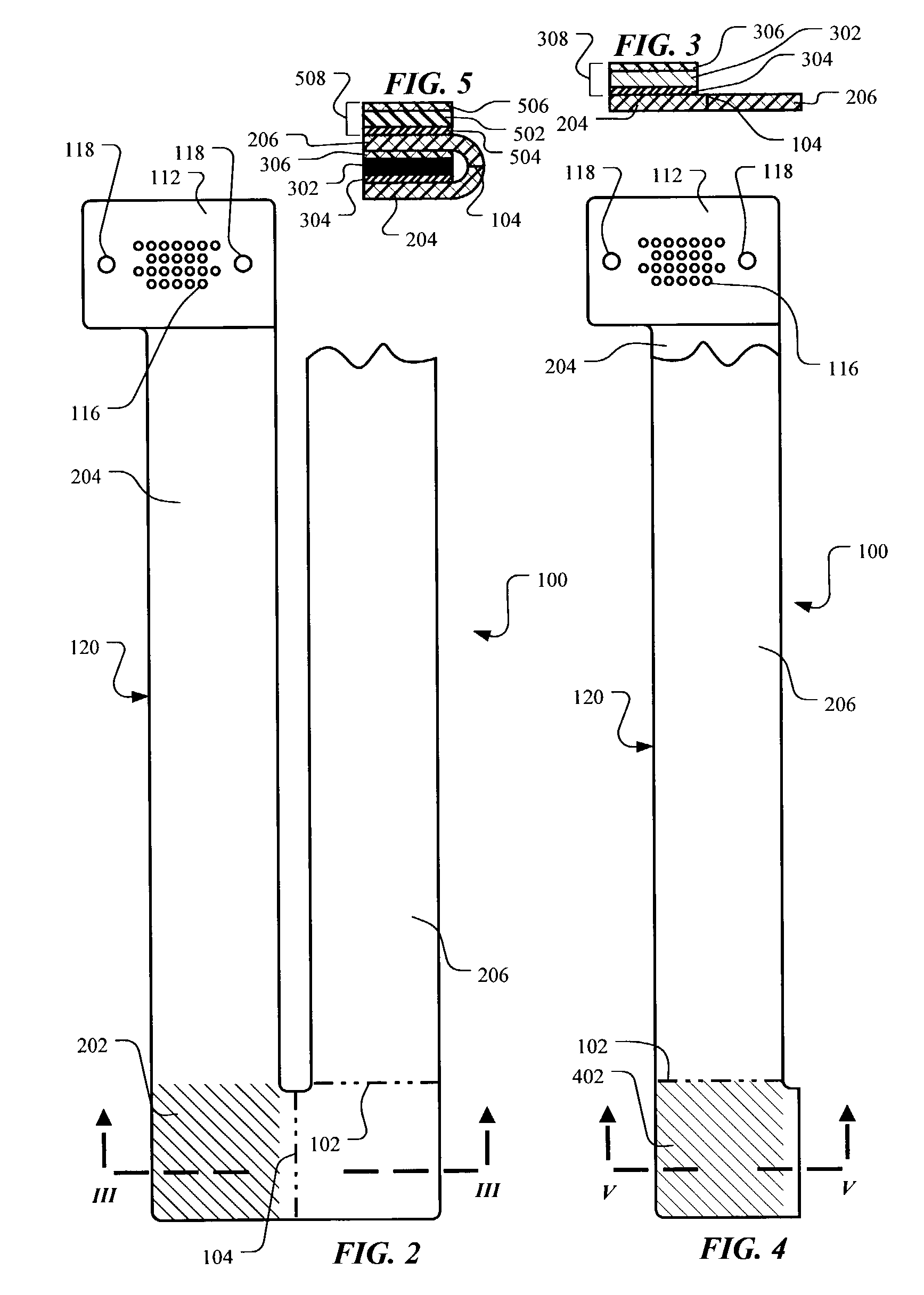Cable and method
a technology of cable and cable, applied in the field of cable, can solve the problems of loosening of the connection, affecting the flexibility of the cable, and affecting the service life of the cable,
- Summary
- Abstract
- Description
- Claims
- Application Information
AI Technical Summary
Benefits of technology
Problems solved by technology
Method used
Image
Examples
first embodiment
[0050]According to the present invention, the cable 100 may be folded into an elongated form as illustrated in FIGS. 2–7. Referring to FIGS. 2 and 3, a first shim 302 is adhesively bonded to an area 202 (indicated by hatching) of the intermediate portion 120 by a first layer of adhesive 304. A second layer of adhesive 306 is then applied to the first shim 302. Alternatively, a shim assembly 308 having adhesive layers 304, 306 that have been pre-applied to the first shim 302 may be used. In this situation, the shim assembly 308 may be applied as a unit to the area 202 of the intermediate portion 120. The intermediate portion 120 is then folded along the fold line 104 so that a second leg 206 may be placed into contact with the second adhesive layer 306, thus adhesively bonding the second leg 206 to the first shim 302, as illustrated in FIGS. 4 and 5.
[0051]Still referring to FIGS. 4 and 5, a second shim 502 is bonded to an area 402 (indicated by hatching) of the intermediate portion 1...
second embodiment
[0056]Alternatively, it may be desirable to decrease the number of shims over the embodiment illustrated in FIGS. 2–7. Thus, according to the present invention, the cable 100 may be folded into an elongated form as illustrated in FIGS. 11–16. Referring to FIGS. 11 and 12, a shim 1202 is bonded to an area 1102 (indicated by hatching) of the intermediate portion 120 by a first layer of adhesive 1204. A second layer of adhesive 1206 is then applied to the shim 1202. Alternatively, a shim assembly 1208 having adhesive layers 1204, 1206 that have been pre-applied to the shim 1202 may be used. In this situation, the shim assembly 1208 may be applied as a unit to the area 1202 of the intermediate portion 120. The intermediate portion 120 is then folded along the fold line 105 so that a first leg 204 is placed into contact with the second adhesive layer 1206, thus adhesively bonding the first leg 204 to the shim 1202, as illustrated in FIGS. 13 and 14.
[0057]Still referring to FIGS. 13 and 1...
third embodiment
[0061]It may be desirable in certain situations to fold the cable 100 diagonally, rather than generally perpendicular to the side edges of the cable 100. Thus, according to the present invention, the cable 100 may be folded into an elongated form as illustrated in FIGS. 18–25. Referring to FIGS. 18 and 19, a first shim 1902 is bonded to an area 1802 (indicated by hatching) of the intermediate portion 120 by a first layer of adhesive 1904. A second layer of adhesive 1906 is then applied to the first shim 1902. Alternatively, a shim assembly 1908 having adhesive layers 1904, 1906 that have been pre-applied to the first shim 1902 may be used. In this situation, the shim assembly 1908 may be applied as a unit to the area 1802. The intermediate portion 120 is then folded along the fold line 108 so that a third leg 1804 may be placed into contact with the second adhesive layer 1906, thus adhesively bonding the third leg 1804 to the first shim 1902, as illustrated in FIGS. 20 and 21.
[0062]...
PUM
| Property | Measurement | Unit |
|---|---|---|
| thickness | aaaaa | aaaaa |
| pressure-sensitive | aaaaa | aaaaa |
| pressure | aaaaa | aaaaa |
Abstract
Description
Claims
Application Information
 Login to View More
Login to View More - R&D
- Intellectual Property
- Life Sciences
- Materials
- Tech Scout
- Unparalleled Data Quality
- Higher Quality Content
- 60% Fewer Hallucinations
Browse by: Latest US Patents, China's latest patents, Technical Efficacy Thesaurus, Application Domain, Technology Topic, Popular Technical Reports.
© 2025 PatSnap. All rights reserved.Legal|Privacy policy|Modern Slavery Act Transparency Statement|Sitemap|About US| Contact US: help@patsnap.com



